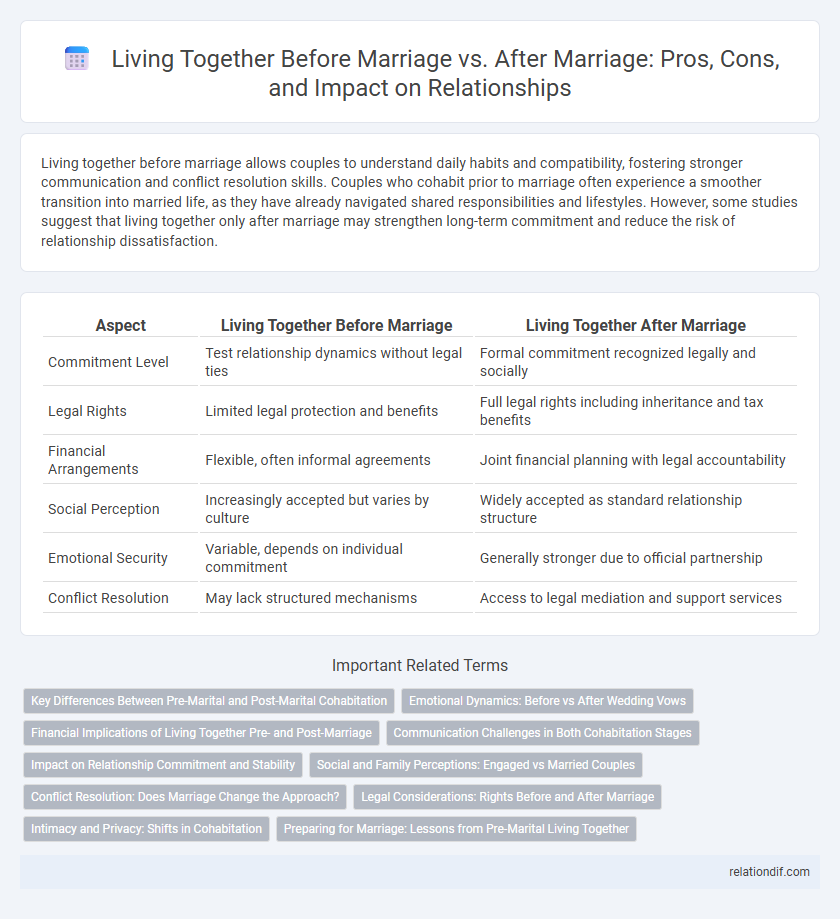Living together before marriage allows couples to understand daily habits and compatibility, fostering stronger communication and conflict resolution skills. Couples who cohabit prior to marriage often experience a smoother transition into married life, as they have already navigated shared responsibilities and lifestyles. However, some studies suggest that living together only after marriage may strengthen long-term commitment and reduce the risk of relationship dissatisfaction.
Table of Comparison
| Aspect | Living Together Before Marriage | Living Together After Marriage |
|---|---|---|
| Commitment Level | Test relationship dynamics without legal ties | Formal commitment recognized legally and socially |
| Legal Rights | Limited legal protection and benefits | Full legal rights including inheritance and tax benefits |
| Financial Arrangements | Flexible, often informal agreements | Joint financial planning with legal accountability |
| Social Perception | Increasingly accepted but varies by culture | Widely accepted as standard relationship structure |
| Emotional Security | Variable, depends on individual commitment | Generally stronger due to official partnership |
| Conflict Resolution | May lack structured mechanisms | Access to legal mediation and support services |
Key Differences Between Pre-Marital and Post-Marital Cohabitation
Pre-marital cohabitation often serves as a trial period where couples assess compatibility, negotiate roles, and establish communication patterns before formal commitment. Post-marital cohabitation typically involves shared responsibilities and long-term planning, reflecting legal, social, and financial integration. Emotional security and societal recognition are generally stronger after marriage, influencing relationship dynamics and stability.
Emotional Dynamics: Before vs After Wedding Vows
Living together before marriage allows couples to navigate emotional dynamics with a focus on daily habits and conflict resolution without the binding commitment of wedding vows, fostering a practical understanding of compatibility. After wedding vows, emotional dynamics often deepen with heightened expectations of loyalty and long-term support, strengthening emotional security but also introducing pressures related to sustained commitment. The shift from cohabitation to marital vows reshapes emotional interactions by intertwining personal growth with collective responsibility.
Financial Implications of Living Together Pre- and Post-Marriage
Living together before marriage often allows couples to share expenses such as rent, utilities, and groceries, potentially reducing overall financial burdens and enabling better budgeting strategies. After marriage, joint financial responsibilities typically become more formalized through shared assets, combined incomes, and possible tax benefits, but couples may also face legal commitments related to debt and property ownership. Understanding these financial implications helps partners make informed decisions about cohabitation and long-term economic planning.
Communication Challenges in Both Cohabitation Stages
Communication challenges in living together before marriage often stem from unclear expectations and lack of long-term commitment, causing misunderstandings about roles and future plans. After marriage, communication difficulties typically involve deeper conflicts related to financial management, in-laws, and long-term decision-making, requiring more mature conflict resolution skills. Both stages demand open dialogue and active listening to navigate emotional, practical, and relational complexities effectively.
Impact on Relationship Commitment and Stability
Living together before marriage often enhances relationship commitment by allowing couples to experience compatibility and conflict resolution skills in real-life scenarios, which can increase marital stability. Studies indicate that cohabitation prior to marriage correlates with a higher likelihood of assessing long-term compatibility, potentially reducing premature divorces. However, some research suggests that couples who cohabit without clear commitment plans may face challenges in stability due to ambiguous relationship expectations.
Social and Family Perceptions: Engaged vs Married Couples
Engaged couples living together often face mixed social perceptions, with some communities viewing cohabitation as a practical step toward marriage, while others consider it socially inappropriate or premature. Married couples living together typically receive stronger family approval and social acceptance, reflecting traditional values that prioritize formal union as the foundation for shared living. These differing perceptions influence familial support, social interactions, and community acceptance for couples based on their marital status.
Conflict Resolution: Does Marriage Change the Approach?
Living together before marriage often allows couples to develop practical conflict resolution skills by navigating daily challenges in real time, fostering open communication and compromise. After marriage, couples may experience a shift in conflict dynamics due to increased emotional commitment and societal expectations, which can either enhance or complicate their approach to resolving disagreements. Research indicates that couples who cohabit before marriage tend to have more effective conflict resolution strategies, but successful marriage depends on continuous effort to adapt and grow through conflict.
Legal Considerations: Rights Before and After Marriage
Living together before marriage, also known as cohabitation, often does not grant partners the same legal rights as those married, including property ownership, inheritance, and decision-making authority during emergencies. After marriage, spouses typically receive automatic legal protections such as joint tax filing, spousal benefits, and next-of-kin rights, which vary by jurisdiction but are generally more comprehensive than those afforded to cohabitants. Couples considering cohabitation should review local laws and may need cohabitation agreements to secure legal rights before marriage.
Intimacy and Privacy: Shifts in Cohabitation
Cohabitation before marriage often enhances intimacy by allowing couples to develop deeper emotional and physical connections in a familiar environment, fostering trust and mutual understanding. Privacy dynamics shift as couples negotiate shared spaces and personal boundaries, balancing individual needs with couple time. After marriage, the formal commitment may lead to heightened privacy expectations and redefined intimacy patterns influenced by social and familial roles.
Preparing for Marriage: Lessons from Pre-Marital Living Together
Living together before marriage helps couples develop effective communication skills, understand daily habits, and resolve conflicts in a real-world setting, significantly increasing marital satisfaction. Studies show that cohabiting partners gain insights into compatibility and shared responsibilities, which prepare them for long-term commitment. These lessons from pre-marital living together contribute to stronger emotional bonds and practical expectations after marriage.
living together before marriage vs after marriage Infographic

 relationdif.com
relationdif.com